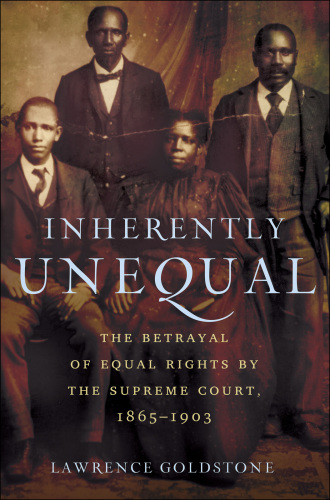
Inherently Unequal
The Betrayal of Equal Rights by the Supreme Court, 1865-1903
کتاب های مرتبط
- اطلاعات
- نقد و بررسی
- دیدگاه کاربران
نقد و بررسی

October 25, 2010
In this comprehensive and remarkably lucid study of post–Civil War Supreme Court decisions, Goldstone (The Activist) shows how the court's narrow interpretation of the 14th amendment—bestowing "equal protection under the law" to all Americans, regardless of race—paved the way for future decisions that diminished the status of African-Americans. While the Civil Rights Act of 1875 guaranteed " the full and equal enjoyment of public conveyances, inns, places of public amusement," it was never truly enforced and was ultimately struck down in 1883 as being unconstitutional by an 8–1 vote. Justice Marshall Harlan, a former slave owner, was the lone dissenter and though vindicated by history, at the time his dissent could not have been more unpopular—even in the North. Goldstone provides rich analysis as well as useful descriptions of the backgrounds, philosophies, and even racism of the key justices. Tracing the makeup of the courts under each administration, Goldstone analyzes how politics and social Darwinism further impeded African-American equality, concluding, "the Court did not render its decisions to conform to the law but rather contorted the law to conform to its decisions."

October 15, 2010
A furious indictment of the Supreme Court as an accessory to the anti-democratic machinations of Gilded Age elites.
Anti-federalist author "Brutus" may have been right when he warned New Yorkers in 1788 that the Supreme Court, as laid out in the Constitution, would become a tool to neuter individual and minority rights, writes Goldstone (The Activist: John Marshall, Marbury v. Madison, and the Myth of Judicial Review, 2008, etc.). The author agrees that it is a defect of Article III that antidemocratic caprice in the high court is immune to democratic check. The author's view of the Court shares much with Peter Irons's A People's History of the Supreme Court (1999), and he also focuses on the decisions of the Chase, Waite and Fuller courts, which undid federal guarantees of equal rights in the aftermath of the Civil War. Bracketed by Slaughter-House (1873) and Giles (1903), this series of decisions emasculated the 13th, 14th and 15th amendments, dismantled Congress's Reconstruction program, condoned the disenfranchisement and quasi-enslavement of the South's African-American population and ushered in the era of oppressive Jim Crow laws. The text is marred by intrusive moralizing and epithetic vehemence, but the biographical sketches and case backgrounds are mostly well-drawn. However, readers' confidence in Goldstone's ability to balance economy and accuracy may be shaken by his misrepresentations of Justice Holmes as a Spencerian, Justice Miller as a hypocrite and Hamilton, Franklin and Darwin as racists.
A creditable condensation of a library of material into a dense 200-page narrative, which an annotated timeline would have helped untangle.
(COPYRIGHT (2010) KIRKUS REVIEWS/NIELSEN BUSINESS MEDIA, INC. ALL RIGHTS RESERVED.)

November 1, 2010
Goldstone places responsibility for the Jim Crow era upon the Supreme Court in the years following the Civil War, in spite of the 13th, 14th, and 15th Amendments, which the court did much to subvert.
Copyright 2010 Library Journal, LLC Used with permission.

























دیدگاه کاربران